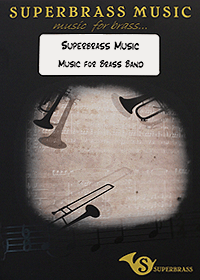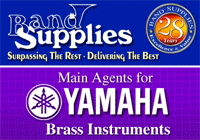The Sopranos: France declares war on the USA
14-Aug-2001The Schilke soprano comes up against the new French model Eb Sop from Courtois - we give our verdict.
Judging one instrument against another may be a pretty dodgy thing to do at the best of times, but the average band player doesn't usually get much of a choice when they come to picking the instrument they want to perform on.
The past few years have seen bands using the National Lottery as the means to "bulk buy" a full set of instruments from makers, who are happy to sell their wares usually on the basis of what constitutes a good financial deal rather than what specific instrument should suit each individual player.
This doesn't mean that buying nine cornets, or three horns or four basses of the same make is the wrong thing to do usually it makes senses in terms of intonation, tonal quality etc, but individual instruments vary greatly and it is still well worthwhile asking to try out 20 cornets of the same make before picking the 9 your band will buy and ultimately use. Not many bands do this though.
When it comes to the specialist positions though, certain manufacturers tend to markedly make better models than the rest. The flugel, bass trombone and soprano are cases in point and so we've made the move to try and test run the leading instruments to see what we think really is the best.
This month it's the battle of the sopranos.
Schilke from Chicago, USA has long been regarded as the best Eb soprano cornet on the market. Like a Mercedes Benz motorcar, it has built up an enviable reputation as the best against its rival producers. In terms of build quality, intonation, tonal quality and sound production it has been seen and heard to have been literally streets ahead of any rival manufacturers efforts. Possibly until now.
Antoine Courtois the French instrument makers from Amboise have released their new 107A, their new Eb soprano which has been developed to try and break into the market that has for a long time now has been the preserve of the American maker. So is it the All American "Uber Sop" from Chicago or the new sleek "Suave Sop" from Paris that is in our opinion the new market leader.
Read on
We've marked the instruments out of 25 in 4 categories to give a final mark out of 100. (Adjudicators eh?)
Build Quality:
No doubting the Schilke here. Build quality of a top of the range Mercedes, top-notch valves, precision engineering, excellent silver plating, sturdy, unpretentious, made for the purpose. It does what it says on the tin (or silver plate in our case). All the bits and bobs work well with strong well-positioned slide pushes and water keys. Built to last, even if you have sweatier hands than a teenager outside Soho strip joint. 23 points.
The first thing that strikes you about the Courtois is the similarity in it's appearance to the Schilke - although there are some nice little touches that distinguish the French model. The little finger hook encompasses the makers initials, whilst the third slide stop is fixed and can only be fully released by the use of a small screwdriver. The stop itself is in white plastic encased in silver plate. The 3rd slide push ring however is remarkably close to the third valve casing, which causes difficulty in holding the instrument if you have a left hand the size of George Foreman's and not Kylie Minogue's. (The makers say this can be altered to suit though). The rest is pretty good as well with round valve tops, solid tuning slide key and neat rubber washers on the slides. Nice. The only minus point for us was the main water key, which wasn't of the same robustness as the Schilke and seemed to be slightly in the wrong place to get your spit out quickly. 22 points.
Intonation:
The usual bugbear of lesser soprano builders, the Schilke has been improved over the years bit by bit so that today it is the most in tune sop on the market. The perennial problems of sharp top A's is easily overcome by judicious use of the 1st slide, and 1st valve flatness below the stave is minimal. Middle C can be a problem on some models and use of 2/3rd is a good working option. Overall though very, very good - even when whacking it out on the top stuff.
20 points.
The Courtois seemed to be a bit flat when we first got it, but after a while it played remarkably well in tune even though we did have to push the main tuning slide in a fair bit. Top A's were still a little sharp, but a quick fiddle on the 1st slide soon sorted it out. Below the stave, the instrument sounded safer than the Schilke with the 3rd slide on our test instrument constantly about 1.5 cm's pushed out giving a less sharp note on bottom D's and C#. (Although why any sop player should be playing down there is beyond us). Well in tune on the very top stuff as well even when we were bursting a few blood vessels.
21 points.
Ease of blowing and tonal quality:
This is the real forte (or fff) of the Schilke. Screw it onto your chops and you can just about sound like a poor man's Peter Roberts. Lovely tone when played well and when you strike a note cleanly. (Just listen to Mr Roberts). Easy to blow throughout the range both above and below the stave and a good technique is rewarded when playing quietly as the instrument retains it's timbre (always wanted to use that word!). Brilliant. 23 points.
The Courtois appeared to be less easy to blow on the very high stuff to start, though it was noticeable easier up to top Bb. Perhaps it was just us, but we felt you had to push a bit more from your nether regions to equal the Schilke up top. Below the top C's though and the instrument was a joy. Clean and clear, the tone quality was sustained throughout the dynamic range especially just above the stave where it was as pert as Geri Halliwell's bikini bottoms. Excellent. 22 points.
Overall Performance and Value for Money:
The Schilke has been around a long time, but the years have been kind to a classic instrument. Built to last longer than the Third Reich it's quality shines through as it should for a Recommended Retail Price of £1935.00. A Beryllium Bell for that extra bit of Ping! will knock you back another £95.00 and the case to carry your lovely model in will cost a further £215.00. Not cheap but then who said real quality was. Overall it's still a brilliant instrument, but maybe it could do with a tweak more improvement here and there. 20 points.
The Antoine Courtois is new and rather untried at the top level of banding, but Alan Wycherley no less plays one and he doesn't make a bad sound does he? The French makers have finally knocked out a soprano of excellent build quality, good intonation and easy to blow with a good tonal timbre. It's not cheap either with a direct selling price of £1500 inc vat with a case and mouthpiece, but the makers will amend the instrument so that you can get your hand to fit a bit more snugly than ours. It's better value for us than the slightly premium priced Schilke. 22 points.
4BarsRest Verdict:
|
|
Schilke |
Courtois |
|
Build Quality: |
23 |
22 |
|
Intonation: |
20 |
21 |
|
Ease of blowing and tonal quality: |
23 |
22 |
|
Overall Performance and Value for Money: |
20 |
22 |
|
total: |
86 |
87 |
A close run victory for the French for us then but it was really too close to call for comfort.
Both are great instruments and perhaps the arrival of the Courtois will push Schilke to improve on their classic model even further. Either way it should be good news for all those underrated, hard working, undervalued, artistic genius's who occupy the soprano cornet chair in your bands. Give them a Schilke or Courtois for Christmas and they won't be able to blame their tools for the split top C at the end of the test piece anymore.
For further information about the instruments you should contact:
Schilke: Phil Parker Ltd, 106A Crawford Street, London W1H 1AL. Tel: 020 7486 8206
Courtois: Fred Rhodes Ltd. The Doyen Centre, Vulcan Street, Oldham, Lancashire. Tel: 0161 620 5899









